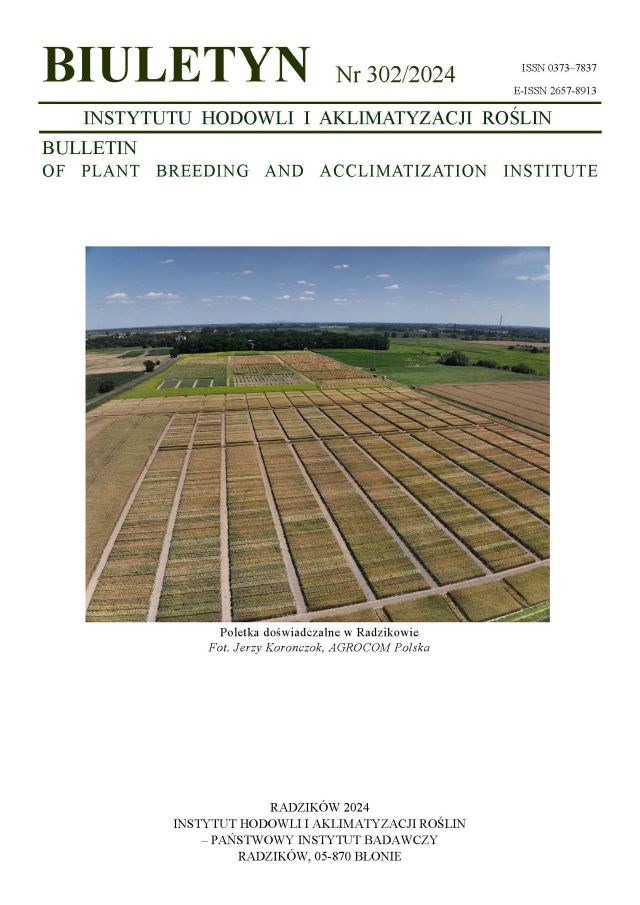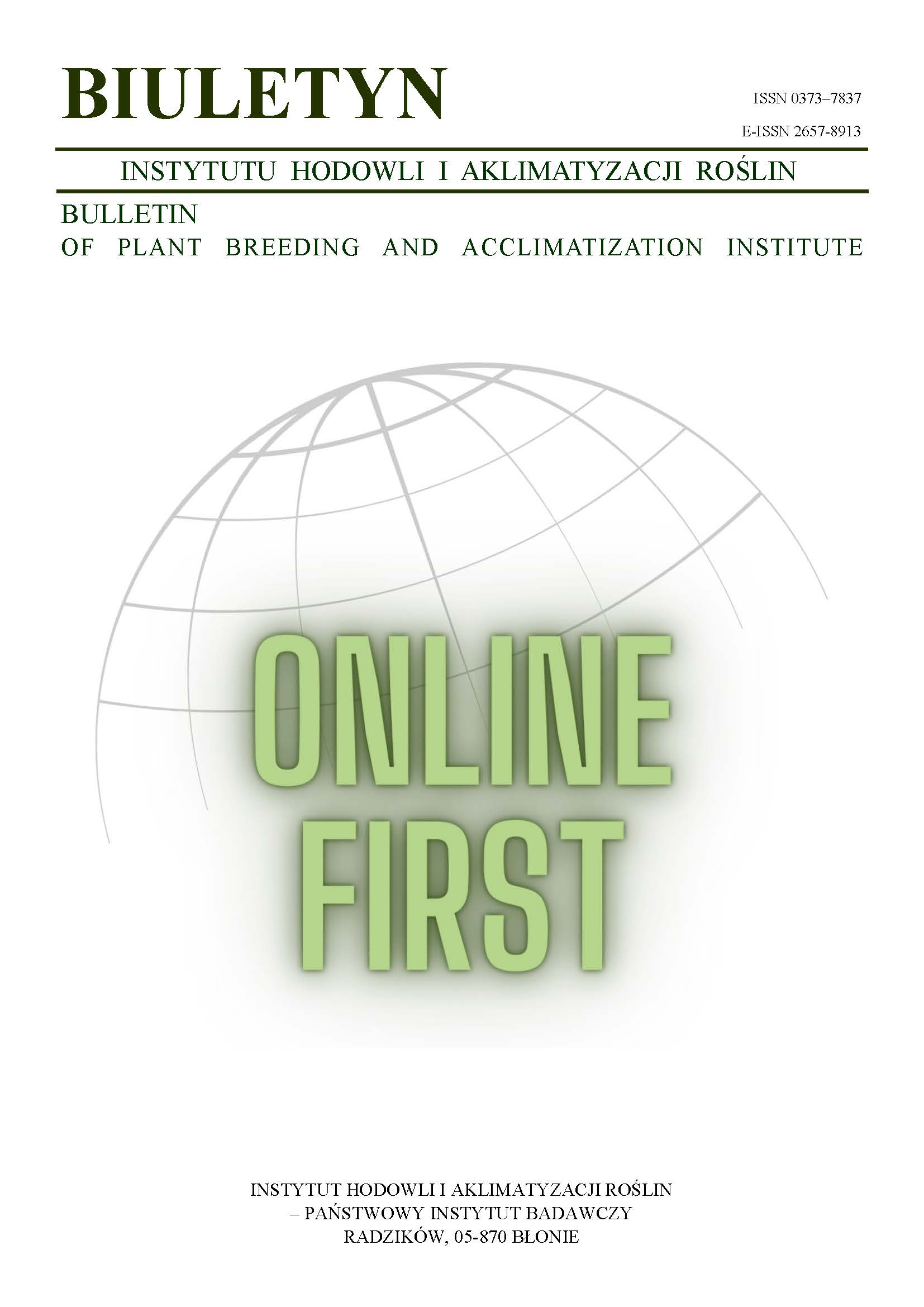Pre-breeding of maize with improved resistance to ear rot and stalk rot
Elżbieta Czembor
e.czembor@ihar.edu.plInstytut Hodowli i Aklimatyzacji Roślin, Radzików (Poland)
Roman Warzecha
Instytut Hodowli i Aklimatyzacji Roślin, Radzików (Poland)
Józef Adamaczyk
Hodowla Roślin Smolice Sp. z o.o. (Poland)
Zbigniew Kurczych
Hodowla Roślin Rolniczych „Nasiona Kobierzyc” Sp. z o.o., Kobierzyce (Poland)
Abstract
Effect of selection for ear rot and stalk rot resistance was tested in two flints and two dent maize synthetic varieties. Ear rot was observed after inoculation by Fusarium graminearum and F. culmorum. Stalk rot was estimated at natural infection. The inoculation of maize ear was effective for differentiation of the tested plant material. The investigated synthetic varieties were characterized as susceptible to ear rot and weekly resistant to stalk rot. The lines have been selected with much higher resistance to the diseases, in relation to the initial synthetic varieties.
Keywords:
ear rot, stalk rot, maize, selectionReferences
Abbas H. K., Mirocha C. J., Komendhal T., Bumes P. M., Meronuck R. A., Gunther R. 1988. Toxigenicity of Fusarium proliferatum and other Fusarium species isolated from corn ears in Minnesota. Phytopathol. 78: 1258 — 1260.
DOI: https://doi.org/10.1094/Phyto-78-1258
Google Scholar
Adamczyk J. 1998. Przegląd metod hodowli kukurydzy i ich skuteczność w praktyce. Biul. IHAR 208: 123 — 130.
Google Scholar
Adamczyk A., Rogacki J. 2005. Co wpływa na plon kukurydzy. W: Kukurydza rośliną przyszłości. Wyd. 3, Warszawa: 22 — 27.
Google Scholar
Bottalico A., Logriecom A., Visconti A. 1989. Fusarium species and their mycotoxins infected cereals m the field and in stored grains. In: Fusarium — Mycotoxins, Taxonomy and Pathogenicity, vol. 2 In: Topics in secondary metabolites. Chełkowski J. (ed.), Elsevier, Amsterdam, The Netherlands: 85 — 119.
DOI: https://doi.org/10.1016/B978-0-444-87468-9.50010-9
Google Scholar
Chełkowski J., Kwaśna H. 1986. Zagrożenie upraw kukurydzy fuzariozą kolb i mikotoksynami fuzaryjnymi. Ochrona Roślin l: 4 — 6.
Google Scholar
Chełkowski J., Prończuk M., Prończuk P. 1993. Observation on fusarium ear rot in maize and related species in Poland. Hod. Rośl. Aklim. 37 (4): 41 — 46.
Google Scholar
Clements M. J., Kleiinschmidt C. E., Maragos C. E., Pataky J. K., White D. G. 2003. Evaluation of inoculation techniques for Fusarium ear rot and fumonisin contamination of corn. Corn Dis. 87: 147 — 153.
DOI: https://doi.org/10.1094/PDIS.2003.87.2.147
Google Scholar
Dolstra O., Marton C., Menzi M., Mohr I., Plieneger D. L, Prończuk M. 1993. Evaluation of recurrent selection for stalk rot resistance in a synthetic maize population. In: Proc. of Maize and Sorghum — Eucarpia XVIth Conference on Breeding and Molecular Biology Accomplishments and Future Promises. Bergamo, Italy, 6–9, 1993: l — 7.
Google Scholar
Dubas A. 2001. Aktualne problemy uprawy kukurydzy w Polsce. Wieś Jutra 6 (35): 7 — 8.
Google Scholar
Jarvis J. L., Ciark R. L., Guthrite W. D., Berry E. C., Russell W. A. 1984. The relationship between second-generation European com borers and stalk rot fungi in maize hybrids. Maydica 29: 247 — 263.
Google Scholar
Mesterhazy A. 1989. Progress in breeding of wheat and com genotypes not susceptible to infection by Fusaria. In: J. Chełkowski (ed.) Fusarium Mycotoxins, Taxonomy and Pathogenicity. Elsevier, Amsterdam: 357 — 386.
DOI: https://doi.org/10.1016/B978-0-444-87468-9.50026-2
Google Scholar
Logrieco A., Moretti A., Ritieni A., Chełkowski J., Altomare C., Bottalico A., Randazzo G. 1993. Natural occurrence of beauvericin in preharvest Fusarium subglutinans infected corn ears in Poland. J. Agric. Food Chem. 41: 2149 — 2152.
DOI: https://doi.org/10.1021/jf00035a061
Google Scholar
Pascale M., Visconti A., Avantaggiato G., Prończuk M., Chełkowski J. 1999. Mycotoxin contamination of maize hybrids after infection with Fusarium proliferatum. J. Sci. Food Agric. 79: 2094 — 2098.
DOI: https://doi.org/10.1002/(SICI)1097-0010(199912)79:15<2094::AID-JSFA505>3.0.CO;2-P
Google Scholar
Perkowski J., Chełkowski J., Plattner R. D., Goliński P. 1991. Cumulation of mycotoxms in maize cobs infected with Fusarium graminearum. Mycotoxin Res. 7A: 115 — 120.
DOI: https://doi.org/10.1007/BF03192195
Google Scholar
Presello D. A., Reid L. M., Mather D. E. 2004. Resistance of Argentine maize germplasm to Giberrella and Fusarium ear rots. Maydica 49: 73 — 81.
Google Scholar
Prończuk M., Prończuk S. 1987. Przydatność „metody chłodniowej" w ocenie odporności życicy trwałej na Fusarium nivale (Fr) Ces. Biul. IHAR 162: 27 — 32.
Google Scholar
Prończuk M, Bojanowski J., Warzecha R. 2004. Effect of leaf infection by Kabatiella zeae on stalk rot prevalence and grain yield of maize hybrids. J. Phytopathol. 152: 410 — 415.
DOI: https://doi.org/10.1111/j.1439-0434.2004.00864.x
Google Scholar
Prończuk M., Prończuk S., Mesyasz M. 1991. Pathogenicity of Fusarium spp. contributing the stalk rot of maize in Poland. Mycotoxin Res. 7A: 97 — 101.
DOI: https://doi.org/10.1007/BF03192193
Google Scholar
Reid L. M., Stewart D. W., Hamilton R. I. 1996. A 4-year study of the association between gibberella ear rot severity and deoxynivalenol concentration. J. Phytopathol. 144: 431 — 436.
DOI: https://doi.org/10.1111/j.1439-0434.1996.tb00319.x
Google Scholar
Ross P. F., Rice L. G., Osweiler G. D., Nelson P. E., Richard J. L., Wilson T. M. 1992. A review and update of animal toxicoses associated with fumonisin-contaminated feeds and production of fumonisins by Fusarium isolates. Mycopathol. 117: 109 — 114.
DOI: https://doi.org/10.1007/BF00497286
Google Scholar
Scott G. E., King S. B. 1984. Sample size to detect genotypic differences in maize to kernel infection by Fusarium moniliforme. Maydica 29: 151 — 160.
Google Scholar
Shelby R. A., White D. G., Bauske E. M. 1994. Differential fumonisin production in maize hybrids. Plant Dis. 78: 582 — 584.
DOI: https://doi.org/10.1094/PD-78-0582
Google Scholar
Teich A. H. 1989. Epidemiology of corn (Zea mays L.) ear rot caused by Fusarium spp. In: Fusarium — Mycotoxins, Taxonomy and Pathogenicity. Chełkowski J. (ed.), Elsevier, Amsterdam, The Netherlands: 319 — 328.
DOI: https://doi.org/10.1016/B978-0-444-87468-9.50024-9
Google Scholar
Authors
Elżbieta Czembore.czembor@ihar.edu.pl
Instytut Hodowli i Aklimatyzacji Roślin, Radzików Poland
Authors
Roman WarzechaInstytut Hodowli i Aklimatyzacji Roślin, Radzików Poland
Authors
Józef AdamaczykHodowla Roślin Smolice Sp. z o.o. Poland
Authors
Zbigniew KurczychHodowla Roślin Rolniczych „Nasiona Kobierzyc” Sp. z o.o., Kobierzyce Poland
Statistics
Abstract views: 23PDF downloads: 6
License
Copyright (c) 2005 Elżbieta Czembor, Roman Warzecha, Józef Adamaczyk, Zbigniew Kurczych

This work is licensed under a Creative Commons Attribution-ShareAlike 4.0 International License.
Upon submitting the article, the Authors grant the Publisher a non-exclusive and free license to use the article for an indefinite period of time throughout the world in the following fields of use:
- Production and reproduction of copies of the article using a specific technique, including printing and digital technology.
- Placing on the market, lending or renting the original or copies of the article.
- Public performance, exhibition, display, reproduction, broadcasting and re-broadcasting, as well as making the article publicly available in such a way that everyone can access it at a place and time of their choice.
- Including the article in a collective work.
- Uploading an article in electronic form to electronic platforms or otherwise introducing an article in electronic form to the Internet or other network.
- Dissemination of the article in electronic form on the Internet or other network, in collective work as well as independently.
- Making the article available in an electronic version in such a way that everyone can access it at a place and time of their choice, in particular via the Internet.
Authors by sending a request for publication:
- They consent to the publication of the article in the journal,
- They agree to give the publication a DOI (Digital Object Identifier),
- They undertake to comply with the publishing house's code of ethics in accordance with the guidelines of the Committee on Publication Ethics (COPE), (http://ihar.edu.pl/biblioteka_i_wydawnictwa.php),
- They consent to the articles being made available in electronic form under the CC BY-SA 4.0 license, in open access,
- They agree to send article metadata to commercial and non-commercial journal indexing databases.
Most read articles by the same author(s)
- Monika Żurek, Piotr Ochodzki, Roman Warzecha, The use of allelopathic properties of sorghum (Sorghum bicolor) in reducing weed infestation of cereals , Bulletin of Plant Breeding and Acclimatization Institute: No. 287 (2019): Special issue
- Elżbieta Czembor, Seweryn Frasiński, Monitoring Ustilago maydis population causing common smut of maize in Poland between 2016 - 2019 , Bulletin of Plant Breeding and Acclimatization Institute: No. 293 (2020): Special issue
- Seweryn Frasiński, Elżbieta Czembor, Justyna Lalak-Kańczugowska, The impact of fusarium ear rot in Poland and methods to reduce losses caused by the disease , Bulletin of Plant Breeding and Acclimatization Institute: No. 290 (2020): Special issue
- Elżbieta Czembor, Magdalena Matusiak, Roman Warzecha, Looking for sources of resistance to ear rot and stalk rot on the basis of the pedigree selection , Bulletin of Plant Breeding and Acclimatization Institute: No. 269 (2013): Regular issue
- Marcin Wit , Piotr Ochodzki , Roman Warzecha , Ada Zawadzka , Monika Żurek , Ewa Mirzwa-Mróz , Emilia Jabłońska , Dorota Bylicka , Józef Adamczyk , Anna Rogacka, Janusz Rogacki , Krzysztof Wójcik , Wojciech Wakuliński , Fusarium temperatum — importance and harmfulness in maize crops, search and characterization of resistance sources , Bulletin of Plant Breeding and Acclimatization Institute: No. 286 (2019): Special issue
- Jerzy H. Czembor, Elżbieta Czembor, Aneta Kisiela, Elżbieta Wnuk, Resistance to powdery mildew (Blumeria graminis f.sp. hordei) of spring barley varieties covered by the Post-registration Variety Testing Program in 2022 , Bulletin of Plant Breeding and Acclimatization Institute: No. 299 (2023): Regular issue
- Elżbieta Czembor, Agronomic value of European cultivars of perennial ryegrass (Lolium perenne L.) in the Polish conditions , Bulletin of Plant Breeding and Acclimatization Institute: No. 245 (2007): Regular issue
- Elżbieta Czembor, Seweryn Frasiński, Identification of new sources of resistance for ear rot and stalk rot diseases caused by Fusarium spp. , Bulletin of Plant Breeding and Acclimatization Institute: No. 286 (2019): Special issue
- Elżbieta Czembor, Włodzimierz Majtkowski, Jan Schmidt, Seweryn Frasiński, Damian Marciniak, Creation perennial grasses ecotypes collection and evaluation their suitability for the special purposes , Bulletin of Plant Breeding and Acclimatization Institute: No. 286 (2019): Special issue
- Elżbieta Czembor, Magdalena Matusiak, Piotr Ochodzki, Resistance of maize hybrids to ear rot caused by Fusarium graminearum and F. verticillioides in Poland in years 2008–2009 , Bulletin of Plant Breeding and Acclimatization Institute: No. 270 (2013): Regular issue














